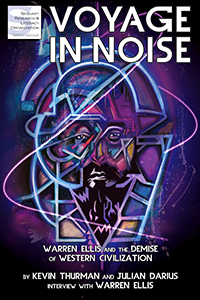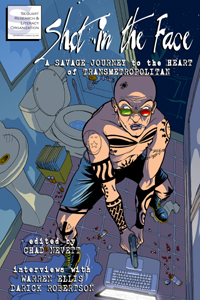Warren Ellis isn’t a prophet.
Sure, 10 years ago, Ellis and Colleen Doran’s Orbiter was released and it begins with the horrific image of a shanty town built around the ruins of the Kennedy Space Center to symbolize the utter ruin of the American space program and this year NASA’s budget has been cut again by $59 million with no chance of manned space-flight to occur in the foreseeable future. But to call Ellis a prophet because he predicted NASA’s decline and then built a narrative around it isn’t very fair to Ellis, because it presumes he received this knowledge via divine intervention rather than by his own sharp perceptions.
While science fiction has been fractured into hundreds of different genres and subgenres, taken at its purest definition, science fiction is fiction that is based on scientific principles. Bad science fiction writers simply use space as setting and aliens as characters (*cough* Star Wars *cough*). Good science fiction crafts a narrative using science to explain wild and fantastic ideas or predict future inventions or products.
But brilliant science fiction requires a little more. Brilliant science fiction uses science to question society and predict the future. And that is what Warren Ellis does with Orbiter.
We never have a full understanding of the decay that the society of Orbiter has endured but the opening scene is enough to give the reader a glimpse of what the future holds for an America without NASA. Orbiter begins with the bottom of a box rotting out and dropping trash all over a NASA banner. A full page spread shows a shanty town of garbage around the Kennedy Space Center where the citizens fight one another for scraps to survive on. Then, the space shuttle Venture returns in a ball of fire killing a number of people. There are only a few brief scenes that take place outside of the Kennedy Space Center and their function is to introduce the main characters rather than flesh out the world itself. Fortunately, the opening scene at the Kennedy Space Center is heavy-handed in its symbolism to show the decay that has come to America in the wake of NASA’s destruction.
NASA itself is a symbol of the pinnacle of American achievement. To quote Sophocles’s Antigone:
Numberless are the world’s wonders, but none
More wonderful than man; the storm-grey sea
Yields to his prows, the huge crests bear him high;
Space flight should be impossible, putting a man on the moon and bringing him home is even more inconceivable, but NASA made it possible. When Neil Armstrong landed on the moon, it was confirmation that American democracy was stronger than Soviet communism. If science fiction dreams of the future, NASA is the means to make it happen. So the destruction of NASA is indicative of a hopeless future and even though we are only shown Kennedy Space Center and the encampment that surrounds it, the reader infers that this is the state of Orbiter’s America in general.
The catalyst for NASA’s destruction was the disappearance of the space shuttle Venture. After crash-landing back at Kennedy Space Center with only one of the original crew members inside, Colonel Bukovic of U.S. Space Command gathers a team of scientists to investigate. Bukovic isn’t given much depth and barely fills the requisite role of “angry military guy” so it’s hard to tell if Ellis is using the character as a criticism of an emphasis on military funding rather or if Bukovic is just there to act as a simple bureaucratic antagonist. Admittedly, history has colored my interpretation of the character as one who has a disdain for science and progress even if Ellis doesn’t go out of his way to flesh this idea out, but this could be said for most of the characters in the graphic novel.
While the ideas in Orbiter are interesting and applicable to today, Ellis is more concerned with developing the mystery and explaining the science of Venture’s return. How did sand from Mars appear on the shuttle? How could Venture travel to Mars and return in perfect condition after 10 years? Did it go anywhere else? Where is the rest of the crew? Why is there a layer of skin that surrounds the space shuttle? Each answer provides more questions and result is a narrative that nearly drowns itself in scientific concepts. Somewhere in the middle of the narrative, the overall message of NASA’s importance seems to get lost, but even though Ellis never gives us a fully-realized world with deep-reaching consequences of NASA’s demise, he distills the loss of innovation into the three main characters; biologist Michelle Robeson, engineer Terry Marx, and psychiatrist Anna Bracken.
Michelle Robeson was a biologist who was in love with space which somehow is the cause for her marriage falling apart (yet another scene that needs further development, but is left vague). Bracken explains that Robeson has “been trapped on this planet since Venture disappeared. It radiates from her. This palpable feeling of something having been stolen from her.” Ultimately, Robeson represents the love of the mystery that is space. There is so much that we don’t know and without space exploration, we are lesser for it. The desire to discover the unknown is essential to our human existence and Robeson is all of that desire.
Terry Marx is a brilliant, spastic engineer. Bracken explains, “he wanted the glory of science and technology. He wanted to build things that took us to space.” So, if Robeson is discovery, then Marx is innovation; she is the investigator and he is the innovator. Without NASA, his innovation goes to waste. In the introduction to Orbiter, Ellis writes that “NASA has always been a political football” and I would extend that to all educational endeavors. Politicians love to cite skewed statistics about how our American education system is failing students in math and science, but by cutting funding to NASA, then what is the purpose of an emphasis on math and science? Maybe that is an overgeneralization, but if NASA is the pinnacle of achievement and that is taken away as an option, then what do students have to aim for?
Finally, perhaps most damning of all, Anna Bracken was a psychiatrist who worked with astronauts and helped them process their feelings about being in space. She explains, “I wanted to see space through their eyes. To see how it changed them, to help them make sense of their experiments. To help them see how glorious and charmed it all is, and to experience that with them. That’s what was taken from me. The wonder.” Bracken is Ellis’s commentary on what has been taken from us all. While a biologist and an engineer aren’t really relatable to the average person, everyone loves the idea of heroic women and men going into space and coming back. We all want to be astronauts, but so very few are cut out to do the job, so we have to experience that feeling through them. Losing that sense of wonder is such a profound loss because there is nothing like it; losing the ability to discover things previously undiscovered.
In the introduction, Ellis explains,
This is a book about returning to space in the face of fear and adversity. It’s a book aqbout glory. About going back to space, because it’s waiting for us and it;s where we’re meant to be. We can’t allow human space exploration to become our history.
But that’s exactly what we’ve done and the consequences of that loss are present in Robeson, Marx, and Bracken. Politicians want economic innovation, give motivation to students in the fields of science and math, and they want to create jobs — what better way to do all three than to increase funding to NASA?


































































